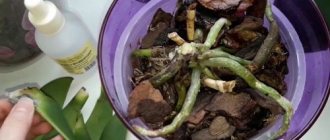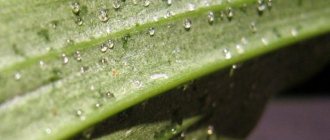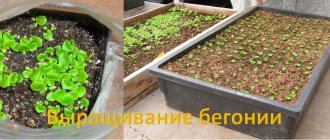Determination of the state of leaf turgor in orchids
Orchid leaf blades are durable and have a dense epidermis that prevents moisture loss.
In many species, such as phalaenopsis, they are thickened and resemble the leaves of succulent plants. Their “fleshy” structure is associated with the ability of orchids to accumulate and hold water. The leaves of healthy orchids normally have a very high turgor index. In biology, turgor is the internal pressure that occurs in cells when water penetrates them. A cell filled with water resembles an inflated balloon, and the internal pressure in it reaches 10 atmospheres. This is what makes the orchid leaf elastic and dense.
Determining whether an orchid’s leaf turgor is normal is very simple. To do this, you need to slightly lift the sheet by the tip with your finger. If strong resistance is felt, the turgor is normal. If the leaf easily and without resistance succumbs to external influences, there are signs of wilting.
Important! The appearance of wrinkles on orchid leaves while maintaining good turgor is not a sign of wilting. After watering, wrinkles quickly disappear. A wilting leaf may not recover even after watering.
Loss of turgor can be reversible or irreversible. If the internal pressure inside the cells becomes less than the minimum permissible values, the cells die, and restoration of such a leaf becomes impossible.
Wilting symptoms
A healthy plant has strong, dense and elastic leaf mass. The normal color is bright green, with a glossy sheen. Often there are fancy patterns and ornaments on the leaves of the orchid.
Symptoms of the disease may include:
- color change;
- withering;
- the appearance of spots;
- loss of turgor;
- wrinkling;
- drying.
Peculiarity! It is believed that the average orchid grows approximately 2-3 leaves per year.
By the changed color, you can determine what exactly provoked the painful conditions. For example, yellow may indicate an overdose of fertilizers, purple may indicate sunburn, reddish may indicate excess lighting, and brown may indicate the appearance of rot.
Possible causes of turgor loss
Orchid leaves lose turgor very slowly. This is clearly noticeable when resuscitating specimens that have lost their root system. Even without roots, orchids can live for a long time, maintaining quite good condition of the leaves.
Therefore, the rarest cause of wilting is overdrying of plants.
Much more often, loss of turgor develops as a result of the following disorders:
| Violation | Mechanism of leaf turgor reduction |
| Chronic waterlogging | Constant flooding, especially with a lack of light, cool air and keeping in unventilated pots, causes rotting of the orchid roots. Diseased roots are unable to absorb and conduct water to the leaves. For some time, the leaves use their own resources, but then the cells become so dehydrated that the turgor drops. |
| Prolonged overheating | If an orchid is left in the hot sun for the whole day, the leaves, in order to cool down, are forced to intensively evaporate water, pumping it out of their cells. As a result, dehydration and a rapid decrease in turgor occur. |
| Hypothermia or frostbite | Exposing an orchid to cold air (+5-70C) for several hours or short-term exposure to frost leads to irreversible changes in the cytoplasm of cells and disruption of all biochemical reactions. The loss of turgor in this case is irreversible. |
| Infection or pest damage | If the infection affects the vascular system of the stem, loss of turgor occurs quite quickly. Damage to the roots by diseases or pests affects the leaves more slowly. Both processes are associated with the impossibility of normal absorption and conduction of water to the leaf plates. |
Thus, before embarking on any measures to restore lost turgor, it is necessary to study the accompanying symptoms.
Regulating watering
If phalaenopsis is watered uncontrollably, then the first thing that comes under attack is the roots of the plant. Next, the pathological process reaches the trunk, leaves and flowers wither and fall off. Lack of watering is no less destructive - the roots become dry, and the orchid dies over time.
To prevent this from happening, water your orchid only when the earthen lump in the pot begins to noticeably dry out. Pay attention to the air temperature in the room, the humidity level - all these factors have a direct impact on the frequency of watering.
Insufficient watering
Insufficient watering is the most common reason why an orchid has limp leaves. If the substrate in the pot is dry, then the roots have nowhere to get moisture and they cannot nourish the shoot.
If the leaves have become soft and wrinkled, you can quickly return them to shape by normalizing watering. To do this, special attention is paid to the root system. Pots for orchids are specially made transparent so that you can see whether the root system has dried out. There should always be condensation on the inner walls of the pot. The watering interval depends on several factors: lighting, room temperature, and looseness of the substrate.
After a few days of proper watering, the leaves regain their elasticity. If the process is slow, a solution of succinic acid is used. The leaves and trunk are washed with it, and the root system is immersed in the solution for several hours. For active growth and flowering, you can spray the entire plant with succinic acid 2 times a month. The optimal temperature of the succinic acid solution is 30-40°C.
A glucose solution will help revive the flower. To prepare syrup 4 tsp. sugar is dissolved in a glass of water. Every evening the solution is applied to the outside of the leaf and washed off the next morning. This prevents excessive moisture loss. The course lasts 4 days, then take a break and, if necessary, repeat the course again.
Watering with sugar water restores the orchid.
Since sugar is a breeding ground for sooty fungus, it is important to rinse off the solution well.
Excessive watering
If your orchid's leaves are wilting, it may be overwatering. In this case, the phalaenopsis withers completely: the roots rot, and healthy ones become insufficient to provide nutrition to the entire plant.
The plant can be cured; this will require a number of measures:
- Remove the plant from the substrate.
- Inspect each root and remove rotten tissue to healthy tissue.
- Treat the sections with charcoal, cinnamon or fungicide powder.
- Leave the roots to dry for 10 hours.
- Prepare a new dry, loose substrate.
- Replant the plant.
The plant needs to be watered when the roots have acquired a bluish-gray tint. If they are bright green, then they have enough moisture to nourish the flower. If the leaves wrinkle, the orchid is left without watering for several days.
Main causes of wilting
Critical temperatures
The plant does not tolerate direct sunlight in hot summers. They cause especially much harm to the orchid after lunch. Wrinkled leaves that release moisture indicate that the flower is overheated. In this case, too much moisture is released, the roots do not have time to absorb it, as a result of which the leaves become soft.
In order for the plant to recover, it must be moved to the shade. Carefully spray the foliage so that water does not get on the flowers. If you ignore this problem, the orchid will die.
When growing this plant, monitoring the temperature is especially important in the summer. In the cold season there should be no threat. If the leaves still wither, perhaps the roots are overheated by the radiators that heat the window sill. Overheating has the same detrimental effect on the plant as direct sunlight. Due to strong heating, moisture quickly evaporates, and the roots constantly lack it.
You can correct the situation with the help of a double pot. Drainage holes are made in the inner container, and the outer one must be completely sealed. Cover the bottom of the outer pot with pebbles or expanded clay. Excess water will go to the pebbles and, evaporating, moisten the roots, which will prevent the soil from overheating.
Lack or excess of moisture
Improper watering is a common cause of foliage wilting. Both overdried soil and excess moisture are dangerous for the plant. In fact, it is very easy to overdry the soil mixture. The microclimate in the room is constantly changing, so it is not always possible to keep track of it. You can determine the problem by moving the plant - if it practically does not move, it means the soil is too dry. If this happens, place the orchid directly in the pot in warm water for half an hour, then remove it and let the excess liquid drain. The plant needs to be watered when the top layer dries out. It is important that the soil always remains loose.
If you overwater a flower, its roots will begin to rot. The problem is complicated by the fact that it is not immediately noticeable. An orchid can even bloom with a diseased root system. When weakened roots can no longer feed the plant, the leaves will begin to wither. In this case, immediate transplantation is required. The old substrate is cleaned from the roots, all damaged parts are cut off, washed thoroughly with water, allowed to dry a little and planted in a new soil mixture. Experienced flower growers recommend treating cuts with cinnamon.
Problem with the root system
If you water your flower enough, maintain the temperature regime, but the leaves are not going to recover, then the problem is in the root system. Interestingly, the orchid is a very tenacious flower. The plant recovers, even if it has only 5 cm of a healthy root. And even if there are no roots left at all, it’s worth trying to revive the beauty.
Soft leaves indicate that the orchid lacks calcium or phosphorus. Move the plant gently in the pot - if it wobbles like a sore tooth, it means the roots are in poor condition.
Remove the flower from the container and carefully examine the roots. Remove dry, rotten, mucus-covered parts with a sharp knife; only healthy tissue should remain. Treat the sections with any antiseptic that does not contain alcohol. Refrain from feeding while the wounds are healing.
Presence of pests or diseases
The leaves of an indoor orchid may wilt due to the plant being damaged by a viral, bactericidal or fungal infection. If you suspect that your flower is infected, then first you should isolate it from its “relatives,” as the infection spreads quickly.
The disease should be combated depending on the pathogen. To treat bacterial diseases, reduce watering, reduce indoor humidity and increase air circulation. The instrument is treated with an antiseptic, and then the affected tissue is removed. After that, treatment with a bactericidal agent is carried out for 5 days. Viral infections are treated by removing the affected areas and creating favorable conditions.
In an orchid affected by the fungus, the affected areas are removed with a sterile pruning shears. After the wounds have healed, the plant is treated with a fungicide in a concentrated form for medicinal purposes.
Poor quality soil
An orchid may have excessively soft leaves due to a poor-quality substrate. The root system of a houseplant must have good ventilation, therefore the substrate must be breathable. If it is dense, then the access of oxygen to the root system is reduced, so the leaves wither.
To solve this problem, you need to replant the plant in new soil. The soil becomes dense and dries out due to regular watering, salt deposition, and the growth of fungus and mold. This soil contains few nutrients needed by indoor plants. Overdried soil can destroy the plant.
An orchid cannot be watered on a schedule. An individual approach is required here.
Temperature, air humidity and light levels change every day. Therefore, you can determine when to water only by the condition of the soil. It should always be loose to ensure access of oxygen to the roots, and moderately moist. You should not create a “swamp” in the pot.
Hypothermia
The orchid is a tropical plant, it is sensitive to the temperature in the room. Keeping a plant in a draft or at sub-zero temperatures causes the leaves to wrinkle, their elasticity to decrease, and they gradually lose all moisture and droop.
In winter, do not place a pot with a plant on the windowsill if the temperature outside reaches -15°C. Completely frostbitten leaves are not treated; they are cut off to avoid the formation of rot and its spread to healthy tissue.
There is no need to replant a supercooled flower. If the orchid has soft, limp leaves, you can save them as follows:
- Inspect the root system, dead roots are removed, and the cuts are processed.
- If all the roots are frozen, you can grow them. To do this, the flower is lowered into the solution. The following are diluted in 1 liter of warm water: 1 ampoule of “Etamon”, 1 drop of “Radipharma”, 4 drops of “Cycron” or 2 drops of “Ribav-Extra”. The roots will grow in 1-2 months if you place the plant in clean water, a mixture of bark and moss, clean moss, or create a mini-greenhouse, for example, from a plastic bottle.
- Return the flower to the dry substrate.
- Provide moderate watering and fertilization.
What to do if leaves and other parts of the plant wilt?
As mentioned earlier, methods for rehabilitating a plant directly depend on the reasons for its wilting. Each case must be considered individually.
Overheating of roots
Despite the fact that orchids come from hot tropical countries, being in direct sunlight or near a running radiator or heater can be detrimental to them. As the temperature rises, moisture evaporates, as a result of which the plant does not receive enough liquid, the leaves become soft and wrinkled.
In case of overheating it is necessary:
- Immediately remove the orchid in partial shade, away from heating devices;
- do not water or spray until completely cooled (at least 2-3 hours);
- if after several hours the leaves begin to rise, water;
- if the damage turns out to be serious and the plant does not begin to recover on its own, more serious measures must be taken, including removing the damaged leaves.
Important! In extreme heat, you should not spray orchids. Watering should be done carefully, preferably when the temperature drops, for example, after sunset.
We invite you to watch an informative video about overheating of an orchid:
Excessive watering and humidity
With excessive watering, the substrate does not have time to dry out, which leads to rotting of the roots; as a result, healthy roots cannot cope with the needs of the plant, the orchid does not receive enough water and minerals (for more information on how to take care of orchid roots so that they are healthy, you can find out here). Sooner or later, this will invariably lead to wilting of leaves and shoots. Rot can spread to the above-ground part of the flower , after which it will be almost impossible to save it (we talked about how to save phalaenopsis if the roots and other parts of the plant are rotting in a separate article).
To prevent this from happening, you must take the following actions:
- carefully remove the orchid from the substrate;
- rinse the roots with warm water;
- remove damaged areas of roots to healthy tissue;
- treat the sections with crushed activated carbon or an antistatic agent, you can also use root;
- leave the flower to dry for 8-10 hours;
- transplant the orchid into a new dry and looser substrate; the drainage layer should be at least 2 cm.
Phalaenopsis orchids need to be watered only after the substrate has completely dried out ; you can determine the need for watering by the color of the roots: roots saturated with moisture are bright green, dry ones are gray.
Below is an informative video about over-watering an orchid:
High concentration of fertilizer
Before using any fertilizer, you must carefully read the instructions for its use and strictly follow them, otherwise there is a high chance of doing more harm to the plant than good. When the damage has already been done, the first step is to immediately abandon further feeding. If after some time this does not bring results, it is necessary to transplant the flower into new, clean soil.
Substrate compaction
On average, phalaenopsis needs to be replanted every 2-3 years , this is due to the natural growth of the root system and deterioration in the quality of the substrate. Over time, the soil in the pot begins to compact, and the natural ventilation of the orchid roots stops, and excess liquid remains inside. As a result, the roots and substrate begin to rot. The only solution to this problem is to transplant the orchid into new soil; in the process, it is necessary to remove the damaged roots.
Stress
If there is a sudden change in external conditions (for example, moving), the plant experiences stress and needs time to adapt before the orchid can return to its normal life cycle.
In this case, it is enough to create comfortable conditions for the flower:
- sufficient lighting;
- air humidity (60-80%);
- timely watering;
- comfortable temperature (+20 – +28 degrees);
- moderate feeding.
Hypothermia (frostbite)
If the air temperature drops below +15 degrees, phalaenopsis has every chance of getting hypothermia . This plant is very sensitive to temperature changes and even a short-term decrease in temperature can lead to leaf wilting. Frostbitten leaves lose their elasticity and acquire a dark green tint; they cannot be restored. Damaged leaves must be removed, and the sections must be treated with an antiseptic or activated carbon powder.
Reference! A supercooled plant should not be replanted, as this may cause additional stress for it.
We invite you to watch the video of how orchids suffer from hypothermia:
Draft
Orchids benefit from daily ventilation , but a constant draft from an open window or running air conditioner can lead to hypothermia and wilting of flowers and even leaves. The only solution in this case is to remove the flower from the ventilated area.
It is contraindicated to ventilate immediately after watering or spraying, as this can lead to additional hypothermia.
We invite you to watch the video of what happens to an orchid under the influence of a draft:
Insufficient watering and air humidity
Phalaenopsis is a tropical plant and is extremely sensitive to insufficient humidity . In the absence of moisture, the roots are not able to nourish the leaves and they become sluggish and gradually dry out (read about why roots, leaves and other parts of the plant dry out here). Insufficient watering also leads to the fact that the plant does not receive the minerals found in the substrate, since they can only be absorbed along with moisture. In the early stages of wilting, it is enough to simply normalize watering to prevent further drying out.
Excessive watering will not help a weakened plant recover and can lead to rotting and death of the plant.
If the lack of moisture has caused serious damage to the plant, the following measures must be taken :
- remove the orchid from the pot;
- place in a container with warm water for 30-40 minutes;
- make sure that the leaves do not touch the water;
- remove from the water and carefully examine the root system;
- remove damaged roots to healthy areas; you may also need to remove some damaged leaves;
- process sections;
In the future, the plant will need timely watering and moderate feeding.
Dense substrate
Air should always circulate between the roots of the orchid. This is a prerequisite for the flower, in addition to the moist environment in the pot. If your phalaenopsis leaves are wrinkled, the cause may be a dense substrate.
The substrate for the orchid should be loose.
The loose substrate provides ventilation for the roots, they remain healthy and do not rot, and excess moisture is easily removed. If the orchid withers, it means that these conditions are not met.
The cause of leaf wilting is eliminated by completely replacing the substrate. Properly processed, high-quality bark easily absorbs water, filtering it through its pores.
Why do orchids have limp leaves?
There are quite a few reasons for leaf wilt. Almost all of them are associated with violations of growing and care conditions. The most common of them are discussed in detail below.
Bay
Bay is one of the most common reasons why leaves turn yellow and their turgor decreases. It occurs when watering too frequently, or in the absence or insufficient number of drainage holes. As a result, excess moisture accumulating in the pot leads to rotting of the roots.
If the level of humidity in the pot is excessive, the air exchange process is disrupted and putrefactive bacteria and pathogenic fungi begin to multiply intensively, which quickly attack the weakened root system. The substrate also begins to sour, which only aggravates the situation. As a result, the roots die and the leaves are deprived of their food source.
Helping a flooded plant is possible only if all measures are completed in a timely manner. It will most likely not be possible to restore a severely damaged root system. If an orchid withers because of the bay, you can help it as follows:
- Gently shake the plant out of the pot.
- Inspect the roots and remove all rotten parts using a sharp knife.
- Treat the cut areas with brilliant green or cinnamon powder.
- The roots are dried for 5-6 hours.
- Planted in fresh substrate.
Overheat
The orchid does not like direct sunlight and hot radiators. If the leaves of a phalaenopsis wither, you need to check the air temperature in the room; the plant may have overheated.
In addition to the sun, heating comes from heated glass if the pot is on the windowsill. The leaves begin to actively evaporate moisture, the substrate heats up, and evaporation occurs in the pot. The roots experience a lack of moisture and cool down as the heat of the substrate is spent on evaporation.
In summer, the maximum air temperature for an orchid is 25°C. If limp leaves are found on the orchid, the pot should be moved to partial shade or another less hot place.
It is necessary to take measures to save the orchid immediately, otherwise the plant will quickly die; in a matter of days it can dry out completely; both the roots and the ground part will dry out to the same extent.
If the plant has been overheated for a short time, a period of several hours to several days will be enough for it to recover on its own. It is forbidden to spray the plant when it is under the sun's rays - this will cause the leaves to get burned. Spraying in summer is effective only in the evening.
When the plant is in the shade and the temperature of the roots and ground parts is equalized, the orchid can be wiped with a damp sponge and watered. To speed up recovery, add succinic acid or a drop of Epin to the water.
Root diseases
The turgor of orchid leaves decreases due to various diseases of the root system. The most common are drying out and rot. To cure a plant, you need to cut off the affected roots, treat them, change the soil, water and fertilize the orchid.
You can tell that the problem is in the root system by its color: healthy roots should be green or have a silvery tint, they feel dense and hard to the touch. Young roots are light, gray, and turn green when wet. If they become soft and weak, hollow, slimy, brown spots, rotten or dry areas appear on them, and water flows out of them when pressed, then urgent treatment is needed. If you do not change the substrate for a long time, algae and bacteria appear on the bark, it wears off and the pores become smaller. Such roots are not able to absorb moisture and nourish the plant.
Until the root system is restored and the cuts are healed, the plant is not fertilized to avoid burns.
Step-by-step guide to restoring an orchid:
- Make sure that the flower has been provided with proper care, that it is not overdried and has not been subjected to overheating or frostbite.
- You can determine the strength of the root system by shaking the plant trunk. If the leaves of a phalaenopsis orchid wither and it wobbles in the ground, the trunk does not hold tightly, which means the roots are damaged.
- If the plant wobbles, then the problem lies in the roots. If it stands firmly, inspection of the roots is carried out in order to prevent and stop the disease at an early stage.
- Rotten, mucus-covered and dried roots are removed.
- Root sections are treated with alcohol-free antiseptics or crushed charcoal.
- Rooting is carried out with the addition of the preparations “Alirin” and “Maxim” to the water.
- If there is at least one healthy root, it is planted in a pot and provided with daily care.
- In the absence of healthy roots, they are built up.
Root rot in an orchid.
Method for growing phalaenopsis roots:
- The flower is placed above a vessel with water, the neck of the flower should be above the water at a distance of 2 cm, that is, none of the parts of the orchid should come into contact with the liquid.
- The container is transferred to a well-lit place, but not under direct sunlight.
- The leaves are wiped on both sides with a special fertilizer for orchids or sprayed with succinic acid. To activate root growth, 4 tablets of acid are diluted in 1 liter of water.
- After an air bath, the leaves are moistened with a mixture of vitamins B1, B6 and B12. 1 ampoule of each vitamin is diluted in 1 liter of water.
You can replant the orchid in the ground when the roots reach 5 cm in length, this will happen in 2-3 months.
If the root has not completely rotted, but only at the edge, and it still has a healthy beginning, then only the damaged part is cut off. The remainder of the root is still able to nourish the orchid, and healthy tissue forms over time at the cut site.
Large amount of fertilizers
Feeding an orchid should be done with caution: both a lack and an excess of feeding can lead to sagging leaves. Before using any fertilizer, you must read the instructions. It is not recommended to mix several types of fertilizers in hopes of getting the best results.
If the orchid's leaves have wrinkled, it may have been watered with a highly concentrated solution. The orchid will die if measures are not taken. If the leaves begin to fall, the substrate is watered with water without fertilizing. In a situation where nothing has changed in several days, it is necessary to change the soil or look for another reason.
Orchids are especially sensitive to phosphorus, potassium and other salts. If there is an excess of them, the leaves may turn yellow and fall off.
What to do and how to save the plant
If the leaves wither for natural reasons, then you should not do anything, but wait until the leaf dries and separates. Then it can be removed.
When it freezes, the first thing to do is remove the orchid from the substrate and inspect the roots. The soft roots are removed, and if the flower is left without roots, the procedure for growing them is carried out. To do this, the base of the orchid, cleaned of roots, is placed 1 cm deep in water with “Kornevin” for 6 hours and then dried.
This is done daily until the flower sprouts new roots. Then the plant can be planted in a new substrate.
The same procedure is carried out for any problems that have led to the loss of roots, but the plant has not yet died.
Diseased roots are always cut back to healthy tissue, and if they are damaged by pests, they are also thoroughly washed. Then the plant is transplanted into a new substrate.
If the soil is salinized with mineral fertilizers or the substrate is too dense, it is necessary that you transplant the plant into new soil. To do this, you will need to buy a special substrate for orchids at a flower shop. It must consist of plant components (pine bark and cones, shells), and be water- and breathable.
Did you know? The cost of one shoot of the Kinabalu Gold orchid can reach 5 thousand dollars. This is a rare species that blooms no earlier than the 15th year of its life.
Pests or diseases
Pests or diseases cause significant damage to the flower. Due to some diseases, the plant may even die, which is why disease prevention is so important.
Pests on the plant are a common cause of flower drying.
The most dangerous is the appearance of insects, which can be not only on the foliage and buds, but in the substrate. If the leaves suddenly begin to dry out and fall off, but there are no visible reasons, most likely insects have infested the soil.
The most common insects and diseases found on orchids are:
- nematodes;
- whitefly;
- aphid;
- spider mite;
- mealybug;
- gray rot;
- black rot;
- powdery mildew.
Because of these pests and diseases, orchids can not only wither, but also die.
Lighting problems
Leaves may wilt due to lighting problems. Orchids are light-loving plants, so a lack of sunlight has a detrimental effect on the flower.
One of the main conditions when growing orchids is that the pot should be located in the sun most of the day. In autumn and winter, when there is not enough sunlight, you can additionally turn on the phytolamps for several hours. They need to be placed 20-30 cm further from the pot.
Note! Do not place pots in open sun. Direct sunlight causes burns on the foliage. The best option is diffused light. In their homeland, orchids generally grow in partial shade.
Why do baby orchid leaves wither?
Why do baby orchid leaves wither? The main reason is that the plant was planted too early. Planting a baby can be done only in cases where three or four roots of two to three centimeters in length have formed and there are at least two leaves. If you trim the baby earlier, there is a high probability of its death. To solve the problem, you can send the shoot to a greenhouse, where suitable conditions are maintained to stimulate growth (temperature 28-29 degrees, humidity about 90%, soft diffused light for 12-14 hours).
Note! The reason for the wilting of the leaves of a baby orchid may also be due to improper care, overheating, hypothermia, etc. In this case, the solution to the problem will be to normalize the living conditions in accordance with the recommendations described above.
Remember that, regardless of the reason for the wilting of the leaves of an orchid of any variety (phalaenopsis, vanda, dendrobium, cymbidium, etc.), you need to tune in to a long recovery process. The exception is when care is disrupted. If you discover a problem with the leaves at an early stage, you will be able to cope in two to three weeks so that the plant is healthy again. If it was possible to find the cause of the wilting of the leaves much later, the resuscitation process can take up to six months. The main thing is to correctly identify the problem and find a suitable solution.
- Author: Maria Sukhorukikh
Rate this article:
- 5
- 4
- 3
- 2
- 1
(0 votes, average: 0 out of 5)
Share with your friends!
What to do to save a wilted orchid
Ways to save an orchid if it has wilted depend on the cause of the flower wilting. The main thing is to notice the problem in time and correctly recognize it in order to cure the plant.
Transplantation as a treatment method
You can replant a flower when insects or diseases appear. But you need to take into account that replanting is stressful for a house plant, so it cannot be done often.
In what cases is it necessary to replant an orchid:
- nematodes, thrips and other pests appeared in the soil;
- the roots began to rot and the leaves began to become flabby due to improper care;
- the soil began to resemble dust.
Important! To replant, you need to purchase a special substrate for orchids.
How to make a transplant correctly:
- If the orchid has recently stopped blooming, the flower stalks are cut off. The lower leaves, if they are dry, can also be cut off.
- Before transplanting, all tools and the pot are disinfected.
- The orchid is carefully removed from the old pot, being careful not to damage the roots.
- Under running water, wash away the remaining soil from the roots.
- Then the root system is carefully examined. If pests are present, the plant should be immersed in warm filtered water for several hours. Then the roots are treated with fungicides against insects.
- Flabby, rotten and dried roots are cut off.
- The cut areas are sprinkled with crushed activated carbon or an antibacterial agent.
- Soft and wrinkled bulbs are also trimmed and the cut areas are treated.
- If the flower has well-developed aerial roots, they do not need to be deeply buried in the soil. Also, do not compact the soil too much; the roots will fix themselves in the substrate after a while.
Note! You can replant the orchid into a new pot only after the roots have dried thoroughly. This takes about 8 hours.
Withering of different parts of the orchid
The lethargy of different parts of the plant depends on certain reasons.
Butonov
Wilting of buds may be due to the fact that the plant does not have the strength to flower after the buds form. Other causes include pest attacks or fungal infections.
Root system
Roots can lose turgor due to an excess of fertilizers, exposure to heat, mechanical damage that is difficult to detect immediately, or fungal diseases. You also need to check the pot - perhaps it is too small for the roots to develop.
Leaf blades during flowering
The orchid spends all its energy on flowering. A healthy plant copes well with this, but if the crop is weakened, it lacks the ability to provide the necessary nutrition to the leaves.
After the purchase
If the orchid withers after purchase, you need to check the soil, since it is often not intended for the normal development of the plant. You should also pay attention to the pot - whether it matches the size of the crop. It is possible that wilting immediately after purchase is a plant reaction to stress.
What to do if the leaves continue to wilt
Replanting does not always help to cope with the problem of withering and fading of leaf color. If this problem is not addressed in a timely manner, the plant may die.
When an orchid's leaves are soft and limp, the reasons are already clear. Now it remains to find out what to do if leaf lethargy cannot be eliminated.
If the leaves continue to wrinkle, although all care errors have been eliminated, then the problem is insects and pests. One transplant does not always help to cope with this problem.
Mealybug on an orchid
What to do if the leaves of an orchid wither:
- with gray rot, white spots covered with fluff appear on the roots. To save the plant, you need to remove all the affected parts of the flower. Sprinkle the sections with a drying agent. Then, intermittently, spray the orchid with fungicides several times. If gray rot reappears, the fungicide must be changed, as the fungus develops resistance to the chemicals;
- With black rot, black spots appear. The stems begin to droop and die. Diseased parts of foliage and stems are cut off. The flower itself is sprayed with foundationazole or topsin. The danger of black rot is its contagiousness, so the diseased plant is removed away from other indoor flowers during treatment;
- the most common disease is powdery mildew. The bush is sprayed with colloidal sulfur or fungicides (topsin or quick). Spraying with foundationazole helps prevent the disease;
- nematodes are the most dangerous insects. They penetrate the plant tissue and feed on its juices. It is almost impossible to remove the pest. Moreover, nematodes quickly spread to other flowers. The only way out is to throw out the diseased plant. You can try to save the flower by spraying it with anthelmintic drugs (decaris or levomisal);
- Wiping the foliage with a soap solution helps against whiteflies. In addition, it is worth treating all the plants in the house. The soap solution also helps get rid of aphids;
- Spider mites are very difficult to notice once they appear. The infestation can be seen by a cobweb-like discharge. The foliage should be washed several times with a soap solution, then sprayed with acaricidal preparations at intervals (10-14 days);
- The mealybug looks like a small fluffy ball. Insects hide in the axils of leaves and on the back side, so you can go unnoticed for a long time. In addition to the fact that the bug sucks juices from the leaves, it provokes the appearance of sooty fungus. To get rid of the pest, you need to thoroughly wash the foliage with soapy water and trim off all dry leaves and pseudobulbs. After this, you need to carry out several sprayings with insecticides.
For your information! Drying and falling leaves do not always indicate a problem. This is a natural process where old leaves die off. If the lower leaves begin to dry out and the rest look healthy, there is nothing to worry about. You don’t even need to trim such leaves; over time, the plant itself will get rid of old and unnecessary leaves.
Reasons why an orchid begins to fade
Overheating of the root system
Orchids love warm and well-lit places. However, everything should be in moderation. Direct sunlight (when it's summer), too hot home heating, blowing hot air currents, the location of the flower in the kitchen are detrimental to the flower. The orchid is designed in such a way that the upper part of the plant heats up and begins to instantly evaporate moisture. Everything would be fine, but the roots of the orchid cool, which in turn stops their absorption of moisture. It turns out that moisture evaporates through the leaves, but is not replenished through the roots. Therefore, the leaves wither in a matter of hours.
All orchids can be classified into three temperature groups
- Heat-loving plants are phalaenopsis, dendrobium and some types of catley. These species require warm conditions all year round. The optimal temperature for orchids of this species varies between: summer daytime 15 - 32 °C and winter nighttime 15 - 18 °C. The daily difference should not be more than 3-5 degrees.
- Medium-temperature plants - odontoglossums, miltonia. These species require cooler conditions. The optimal summer daytime temperature for these species ranges from 18 to 22 °C, and the winter night temperature is 12 to 15 °C.
- Cold-loving plants are Australian dendrobiums, most paphiopedilums, and many laelias. The optimal temperature for these species will be: summer daytime 22°C, winter nighttime 12 - 15°C.
Most orchids you received as a gift or purchased in flower shops will feel great in the temperature range: during the day +18 - +27 °C, at night +13°C - +24°C.
Excessively compacted soil
Substrate is one of the most important foundations for the health of your orchid. If you notice soft and limp leaves on your flower, then most likely the reason is a poor-quality substrate. Poor or old substrate quickly compacts and prevents oxygen from reaching the plant's root system. It should be understood that the substrate must be changed periodically, as it deteriorates and loses the most important property for orchids - the ability to ensure air circulation within the soil. The older the substrate in your peas, the less the orchid roots receive the required amount of oxygen. Also, the rate of aging (compaction) of the substrate is influenced by such factors as the presence of various types of soil fungi, impurities and pests.
Low humidity
Dry soil is extremely dangerous for orchids. Many people plant orchids in narrow and tall pots (this makes it easier to control soil moisture) in order to water the flower almost daily. But it's not right. In general, be careful, orchids cannot be watered according to a schedule. Each orchid should have its own individual approach to watering. Orchids have only recently been domesticated, and memories of how they grew epiphytically in the tropics are still fresh in their minds.
So your orchid is simply yearning for its roots to get wet every day and then be dried out by the blowing warm air. Unfortunately, you will not create such conditions in any apartment. All that is available to us is a high-quality substrate, which simply must dry well. Otherwise, the plant roots will be constantly wet. Consequently, sooner or later they will begin to rot. Healthy roots of any orchid are always hard and dense when you feel them. They are usually light in color, sometimes light brown. But if the roots are brown and feel empty or slippery when touched, those roots are rotten.
High humidity levels
Orchids do not tolerate waterlogging well. The speed at which the substrate dries out is influenced by many factors. For example, if the flower pot has too few holes or their diameter is very small, then it will be very difficult for your orchid to get rid of excess moisture. Factors such as lighting, composition of the substrate, total air humidity and temperature, etc. also play a significant role. With orchids, it is difficult to guess when watering. A month ago, the plant dried out in 7 days, but now the sun is scorching and hot outside the window - the orchid will dry out in 2 days. And with the onset of autumn, when it is rainy and cloudy, the orchid will dry out within 14-18 days. The most important thing for an orchid is a spacious, but not large pot. So that there is enough space for the root system, and you can regulate the volume and time of watering.
Pest beetles
One of the most common reasons for orchid leaves to wilt is the appearance of pests in the substrate, such as click beetle larvae. They are located on the youngest roots and damage them. Damage to young roots leads to the loss of the orchid’s ability to fully absorb moisture and nutrients from the soil. If this happens, the plant urgently needs to rinse the root system. Then transplant the flower into new or disinfected soil. Remember that after transplantation, the orchid can only be watered for 10-14 days.
If you find an error, please select a piece of text and press Ctrl+Enter.
Facebook VKontakte Yandex Twitter Telegram
Why do buds fall off when flowering?
The culture has an extended flowering period. The optimal period is considered to bloom from October to March. Due to the complete discrepancy between room conditions and the usual habitat, flowering is shifted to different periods. When setting buds, the plant concentrates all its energy on future flowering. Complete or partial falling off of tied buds indicates problems. Flower growers begin to look for the reasons why leaves and flowers wither, and buds fall off.
| Possible timing of bud release | Cause |
| in autumn | Lack of lighting. When the peduncle is driven out, the plant does not have enough light for its further development and falls off. For the same reason, the leaves of a blooming orchid wither. |
| Any time of year | Temperature fluctuations, which became a shock for the crop, led to the falling of flowers. |
| in winter | Dry air, increased temperature due to working batteries. First, the leaves begin to wither, then the formed flowers fall off. |
| In summer | Lack of moisture. The roots dry out, this leads to consistent drying out of the above-ground part. |
| Any time of year | Lack of nutrients. |
The shedding of buds is irreversible. When flowers fall off, it is recommended to help remove the half-opened buds and begin treatment.
Advice! If there is a lack of nutrition during flowering, potassium-phosphorus fertilizers are applied. Nitrogen-containing mixtures are excluded, as they contribute to the growth of green mass.
Why does this happen to the flower?
Before you take measures to save a withering plant, you must understand the reason, otherwise any restorative measures may cause even more harm. In most cases, loss of elasticity and yellowing of leaves is observed as a result of the following reasons :
- excessive watering or stagnation of moisture in the substrate;
- insufficient watering and air humidity;
- excess or improper use of fertilizing;
- hypothermia or frostbite;
- overheat;
- compaction, rotting or other changes in the substrate;
- root damage;
- parasites, mold (you can learn more about what diseases and pests can destroy phalaenopsis and how to save the plant in this article).
If, in the midst of flowering, an orchid’s flowers begin to fade and fall off, this is also a reason to analyze the possible causes of what is happening and try to take countermeasures as soon as possible.
The reasons in this case may be:
natural process of plant aging;
- strong drafts, proximity to an air conditioner, heater, open window;
- stress from changes in external conditions;
- excessive spraying or, conversely, insufficient air humidity;
- lack of lighting;
- excessive or insufficient watering;
- parasite infection.
There is no universal way to revive the withered leaves and flowers of an orchid . If the cause of the disease is incorrectly determined, further actions may further weaken the damaged plant and lead to its death.
We invite you to watch an informative video about the reasons for orchid wilting:
Why do leaves wither and turn yellow after transplanting?
Epiphytes and lithophytes are transplanted to a new location after the first flowering or as the pot becomes too small for the overgrown roots. The transplant is carried out according to the established scheme. Orchids are quite capricious, so in order to avoid mistakes, it is recommended to watch special videos and study the information.
For transplantation, select a suitable container and prepare the substrate. The roots are inspected and, if necessary, dry or damaged parts are removed with sharp garden shears. The sections are treated with crushed activated carbon to avoid fungal infection.
The leaves of the transplanted orchid began to wither
The transplant is secured with tray watering, a root biostimulator is added to the water, this will help the plant quickly adapt to new growth conditions. If, after transplantation, the leaf begins to dry out, turn yellow, and take on an unusually limp appearance, then this indicates a problem, a possible violation of the planting rules:
- Aging. This natural cause may become relevant after transplantation. Changing the pot becomes a new stage in the development of the culture, so the reset process is activated. Withering and yellowing of the lower plates is a sign that the flower is renewing itself. In this case, each fallen leaf is removed, no other actions are taken.
- Overflow. After transplantation, a flower reacts to waterlogging by rapid yellowing of the lower part along with the stem. If this reason is discovered, it is advised to normalize the irrigation system and wait until the substrate dries completely.
- Water quality. Plants are sensitive to hard water. Rust and chlorine that get to the root system after replanting can harm the plant. To avoid damage to the roots, hard water is softened by adding citric acid.
- Incorrectly selected container and substrate. Repotting may fail if you choose a pot that is too small or too large. Lack of space compresses the roots and leads to yellowing; too much space provokes the accumulation of moisture, which is also harmful to the plant.
- Moving, incorrect placement. The reason for yellowing and wilting after transplantation may be the wrong choice of location. Exotic flowers do not feel comfortable in the kitchen, where they are often adjacent to fruits and vegetables. Some fruits actively emit ethylene, which leads to the activation of processes inside the flower, which negatively affects its natural development.
Advice! After transplanting, during flowering, it is recommended to water the soil with warm, settled rain or melt water.
What to do if flowers and leaves wither
When purchasing, you want to get a flower that will bloom steadily and delight you with its healthy appearance. If basic care errors cannot be avoided, then they use methods that help eliminate the consequences and cure the plant. The resuscitation process may take a long time, depending on the stage at which treatment was started. In the initial stages of wilting and yellowing, several actions are sufficient:
- change of location;
- additional lighting;
- cessation of watering or additional watering;
- control over air humidity levels, temperature reduction, ventilation.
These actions help to understand why the leaves of an orchid wither and to choose optimal conditions. If none of the options helps, then proceed with the necessary transplantation. When replanting, an additional reason for yellowing and wilting may become clear. This may be rotting of the root collar due to a wet lump of substrate or the presence of pests on the roots. The plant begins to be saved in the early stages of decay. Damaged roots are cut off, processing the cuts, changing the planting container and substrate.
Basic care mistakes
Experienced flower growers advise not to make common mistakes when purchasing and caring for them. This floral look is often purchased for its spectacular appearance, but after being placed on the windowsill, people often don’t know what to do with the plant. The orchid loves attention and careful, non-aggressive care.
Purchase
The first difficulty a gardener may encounter is purchasing a damaged flower. The blooming appearance can be deceiving. Temperature fluctuations lead to the spread of fungus on the roots, so when purchasing, you should pay attention not to the above-ground part, but to inspecting the root system.
The roots should be smooth, the same color, without plaque or dry spots. They should fit snugly into the pot. The formed buds should not fall off when slightly shaken due to their tight attachment to the stem.
Watering
Orchids are often watered from watering cans or through wide trays. This leads to waterlogging of the roots. Irrigation trays should not be too deep and wide, then there will be no excess moisture. There is another method - immersing the pot in a bucket of water.
Experienced flower growers and collectors of exotic flowers water plants using the wick method. When transplanting, a wick is placed at the bottom of the pot, which is constantly moistened. In this way, the stem is constantly fed with a small amount of moisture, which does not lead to an excess.
Accumulation of substrate at the root collar
This is a common problem that causes flower loss. When purchasing, the owner does not have the opportunity to examine the substrate on every part of the container. Moisture-intensive soil accumulates near the root collar and leaves it wet for a long time. Such a moisture-intensive substrate can be a lump from previous transplants, which consists of several layers.
Increasing humidity by spraying
This mistake is associated with the idea of the orchid as a moisture-loving crop. The owners begin to actively spray the plant along its entire length. Sometimes the buds are sprayed. There is no need to do this. An error can lead to rotting and loss of the phalaenopsis. Humidity is important for epiphytes, but this is achieved by installing humidifiers near the pot or spraying the air near it.
Errors in care led to wilting of orchid leaves
The danger comes from pests that appear as a result of imperfect temperature conditions. Humidity or dry air leads to active reproduction of parasites. Orchids are susceptible to attacks from various insects:
- mealybug;
- aphid;
- whitefly;
- spider mite;
- thrips.
The fight against any species involves carrying out step-by-step treatment measures. First, the culture is rid of adult individuals, then the remains of deposited larvae are eliminated, and treatment begins.
What can cause leaves to wilt?
If the color of the leaves does not change, no damage or signs of disease are visible, but they lose turgor (elasticity) - this is a signal of improper care. When this happens to a newly acquired plant, the cause may be a violation of transportation conditions, in particular, low temperature for orchids. This happens if a long-growing orchid is exposed to the cold. This happens more often in winter.
Withering of orchid leaves from the cold.
- Sensitivity appears at +150 and below . For phalaenopsis this is already frostbite .
- Turbulence, that is, draft, is dangerous . Sharp fluctuations in air from hot to cold are intolerable to the plant.
- As a result of improper planting (transplantation ) when the root system is damaged. The ability to absorb nutrients is impaired, causing the plant to weaken.
- If the substrate is infected with pathogens and pests . The orchid wilts from fungal or bacterial pathogens or insects in the soil mixture.
Prevention
To prevent the leaves of an indoor orchid from withering, you need to carefully care for it. This plant does not like sudden changes in microclimate or movement. It is especially important not to touch it during the flowering period. Otherwise, its leaves will wither and the petals will fall off.
Periodically, the orchid is bathed in a warm shower with low pressure. This procedure resembles tropical rain and the plant really likes it. After washing with water, remove all remaining moisture with a soft cloth so as not to provoke the development of rot.
It is also important to monitor the condition of the roots. Orchid plants are usually grown in transparent containers. Therefore, it is not difficult to inspect the root system without removing the flower from the pot. Healthy roots should be greenish in color. If signs of rotting or drying are visible, you need to remove the orchid from its pot and rehabilitate the roots.
Trimming
A faded orchid must be pruned according to the rules so as not to destroy the plant.
When is it time to prune an orchid?
The time from the beginning of October to November inclusive is considered the best period for carrying out this procedure, and it is suitable for almost any type of this wonderful plant. But exotic species (artificial hybrids) are pruned only in the spring, from the first days of March until the end of the month. The name of the flower indicates whether it is a hybrid or an original variety.
Therefore, when purchasing a phalaenopsis for yourself, be sure to pay attention to the name (or write it down) because its entire future life in the house will depend on it.
Using tools when pruning
Oddly enough, but metal scissors or simple garden pruning shears - pruning shears - are better suited for this.
Be sure to disinfect the instrument you decide to use with a solution of ordinary bleach. Try not to trim with a knife, because you can easily accidentally damage the leaves.
A faded orchid must be pruned according to the rules so as not to destroy the plant.
Pruning rules
First of all, carefully examine the flower, check for dormant buds from which children or new flowers can grow.
- In order for the phalaenopsis to bloom again, you need to count down three dormant buds and about 10–15 mm above the last one and cut off the peduncle there. Please note that this pruning method does not have a 100% guarantee that this flower stalk will produce buds or baby buds.
- In addition, if the peduncle is cut off from the top in this way, then there is still the possibility of a flower appearing, but a new stem is unlikely to grow, because the plant will use all its resources to support the old stem.
Cutting off the entire peduncle
A yellowed or completely shriveled stem must be cut off entirely, leaving only a small piece no larger than 20 mm in size. Do not spare the cut flower stalks, because soon the phalaenopsis will again delight you with its beautiful flowers.
Orchid after pruning
Caring for such a phalaenopsis is no different from usual. You just need to fertilize the plant with fertilizer to accelerate the growth of new leaves and the appearance of flowers. If the plant is resting after flowering, then you should not add fertilizers during this period.











